2012 SSANGYONG RODIUS tires
[x] Cancel search: tiresPage 151 of 715
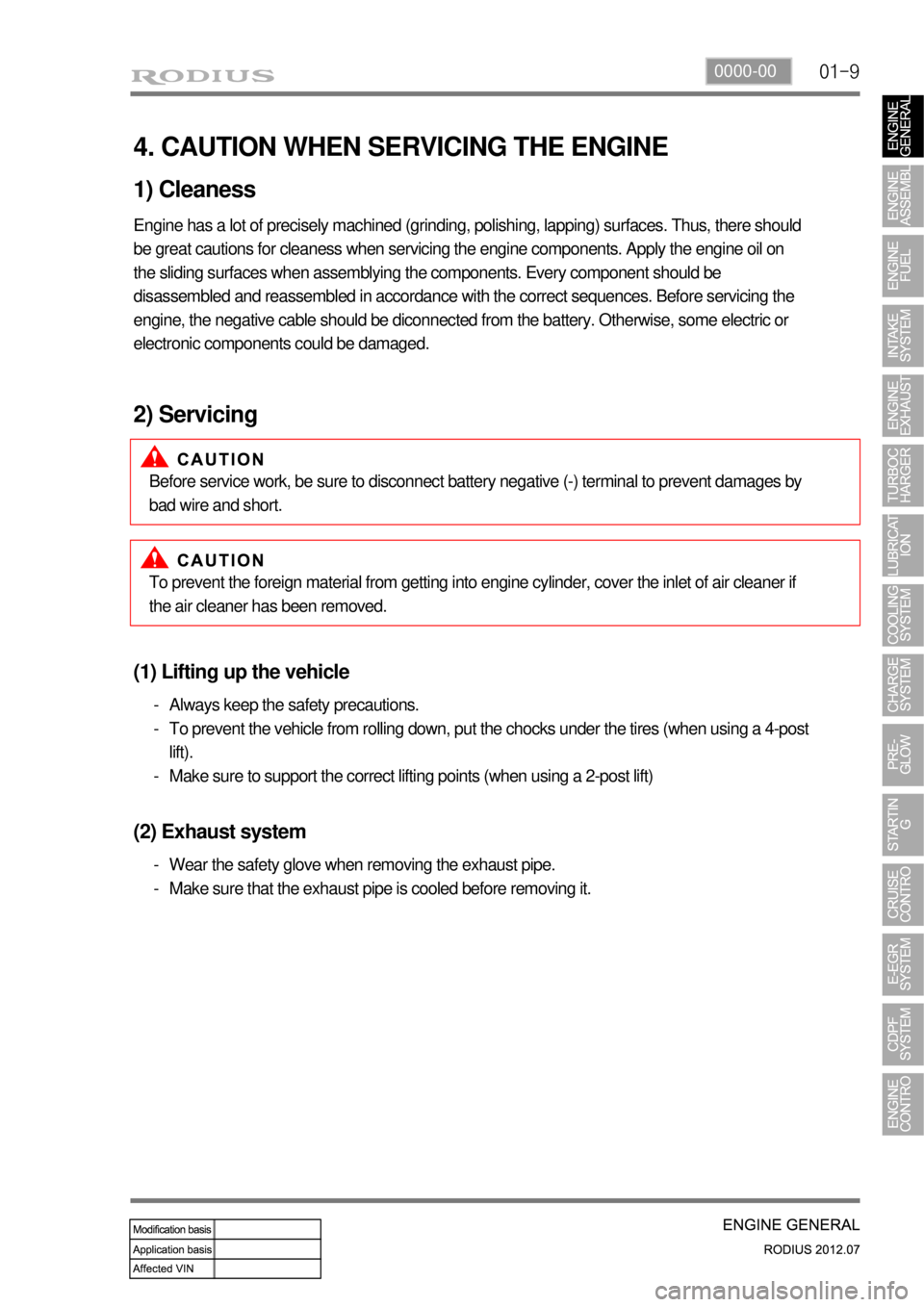
01-90000-00
4. CAUTION WHEN SERVICING THE ENGINE
1) Cleaness
Engine has a lot of precisely machined (grinding, polishing, lapping) surfaces. Thus, there should
be great cautions for cleaness when servicing the engine components. Apply the engine oil on
the sliding surfaces when assemblying the components. Every component should be
disassembled and reassembled in accordance with the correct sequences. Before servicing the
engine, the negative cable should be diconnected from the battery. Otherwise, some electric or
electronic components could be damaged.
2) Servicing
Before service work, be sure to disconnect battery negative (-) terminal to prevent damages by
bad wire and short.
To prevent the foreign material from getting into engine cylinder, cover the inlet of air cleaner if
the air cleaner has been removed.
(1) Lifting up the vehicle
Always keep the safety precautions.
To prevent the vehicle from rolling down, put the chocks under the tires (when using a 4-post
lift).
Make sure to support the correct lifting points (when using a 2-post lift) -
-
-
(2) Exhaust system
Wear the safety glove when removing the exhaust pipe.
Make sure that the exhaust pipe is cooled before removing it. -
-
Page 617 of 715
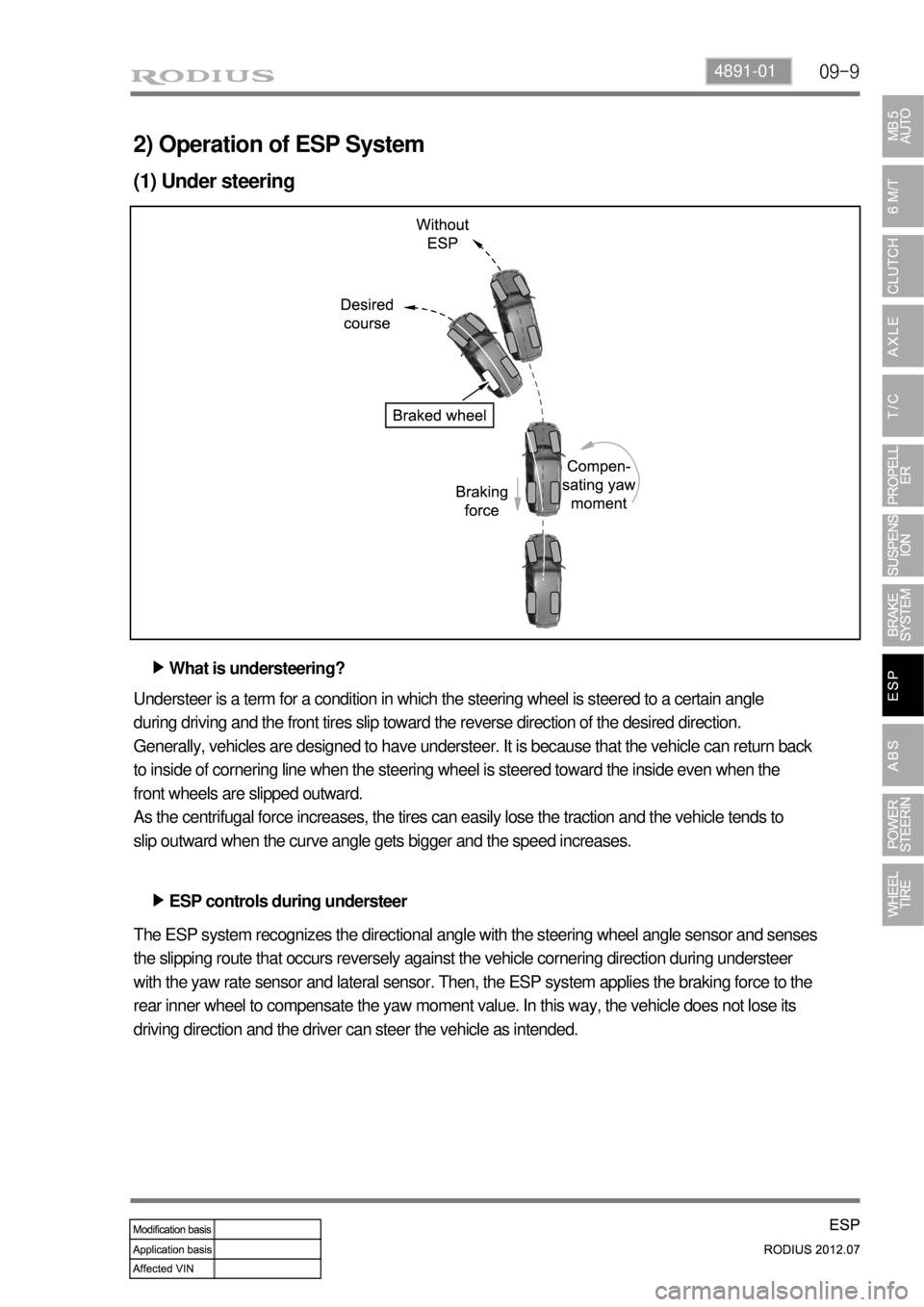
09-94891-01
2) Operation of ESP System
(1) Under steering
What is understeering? ▶
ESP controls during understeer ▶ Understeer is a term for a condition in which the steering wheel is steered to a certain angle
during driving and the front tires slip toward the reverse direction of the desired direction.
Generally, vehicles are designed to have understeer. It is because that the vehicle can return back
to inside of cornering line when the steering wheel is steered toward the inside even when the
front wheels are slipped outward.
As the centrifugal force increases, the tires can easily lose the traction and the vehicle tends to
slip outward when the curve angle gets bigger and the speed increases.
The ESP system recognizes the directional angle with the steering wheel angle sensor and senses
the slipping route that occurs reversely against the vehicle cornering direction during understeer
with the yaw rate sensor and lateral sensor. Then, the ESP system applies the braking force to the
rear inner wheel to compensate the yaw moment value. In this way, the vehicle does not lose its
driving direction and the driver can steer the vehicle as intended.
Page 618 of 715

09-10
(2) Over steering
What is oversteering? ▶
ESP controls during oversteer ▶ Oversteer is a term of a condition in which the steering wheel is steered to a certain angle during
driving and the rear tires slip outward losing traction.
Compared to understeering vehicles, it is hard to control the vehicle during cornering and the
vehicle can spin due to rear wheel moment when the rear tires lose traction and the vehicle speed
increases.
The ESP system recognizes the directional angle with the steering wheel angle sensor and senses
the slipping route that occurs towards the vehicle cornering direction during oversteer with the
yaw rate sensor and lateral sensor. Then the ESP system applies the braking force to the front
outer wheel to compensate the yaw moment value. In this way, the vehicle does not lose its
driving direction and the driver can steer the vehicle as intended.
Page 632 of 715
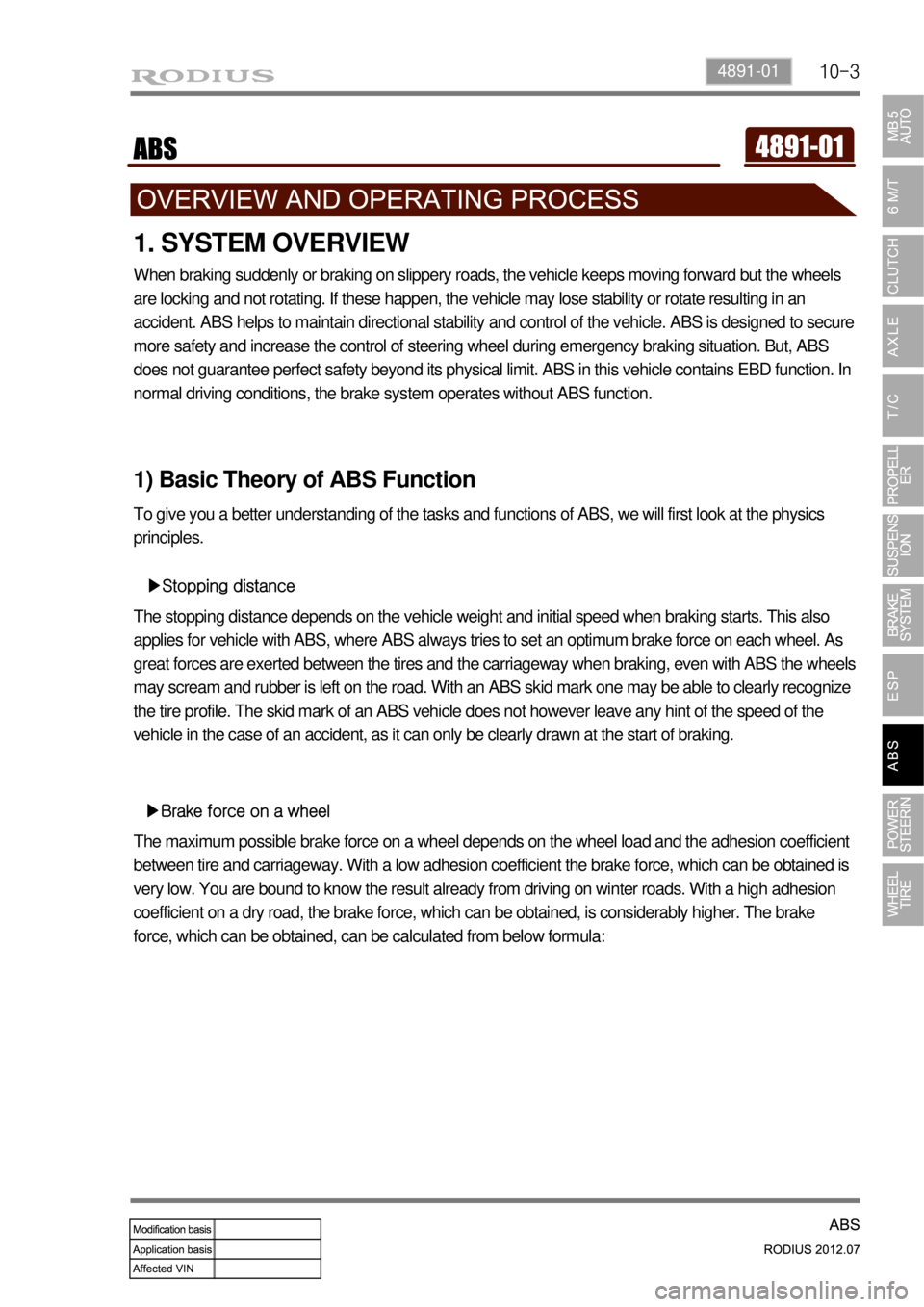
10-34891-01
1. SYSTEM OVERVIEW
When braking suddenly or braking on slippery roads, the vehicle keeps moving forward but the wheels
are locking and not rotating. If these happen, the vehicle may lose stability or rotate resulting in an
accident. ABS helps to maintain directional stability and control of the vehicle. ABS is designed to secure
more safety and increase the control of steering wheel during emergency braking situation. But, ABS
does not guarantee perfect safety beyond its physical limit. ABS in this vehicle contains EBD function. In
normal driving conditions, the brake system operates without ABS function.
1) Basic Theory of ABS Function
To give you a better understanding of the tasks and functions of ABS, we will first look at the physics
principles.
▶Stopping distance
The stopping distance depends on the vehicle weight and initial speed when braking starts. This also
applies for vehicle with ABS, where ABS always tries to set an optimum brake force on each wheel. As
great forces are exerted between the tires and the carriageway when braking, even with ABS the wheels
may scream and rubber is left on the road. With an ABS skid mark one may be able to clearly recognize
the tire profile. The skid mark of an ABS vehicle does not however leave any hint of the speed of the
vehicle in the case of an accident, as it can only be clearly drawn at the start of braking.
▶Brake force on a wheel
The maximum possible brake force on a wheel depends on the wheel load and the adhesion coefficient
between tire and carriageway. With a low adhesion coefficient the brake force, which can be obtained is
very low. You are bound to know the result already from driving on winter roads. With a high adhesion
coefficient on a dry road, the brake force, which can be obtained, is considerably higher. The brake
force, which can be obtained, can be calculated from below formula:
Page 645 of 715
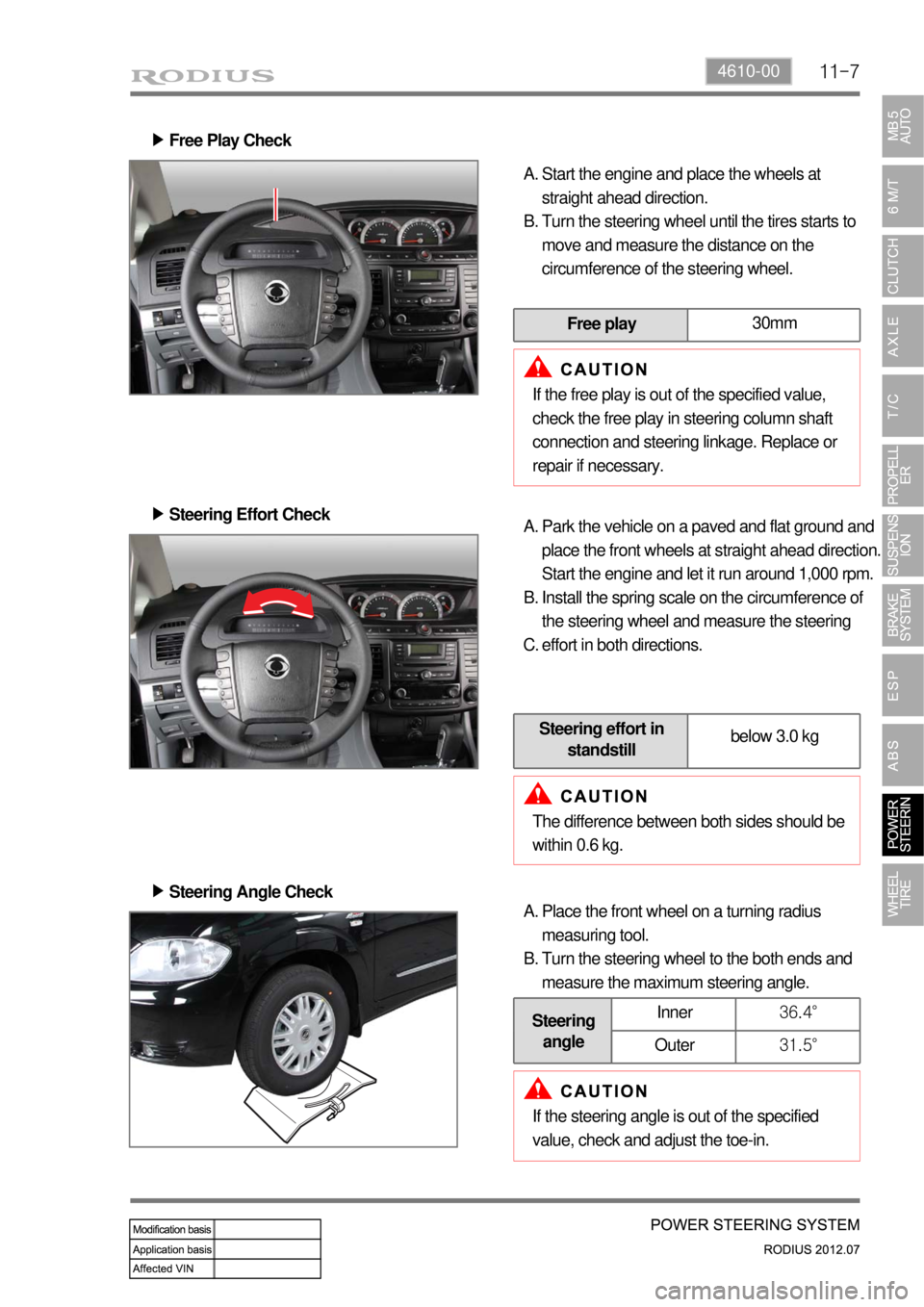
11-74610-00
Free Play Check ▶
Start the engine and place the wheels at
straight ahead direction.
Turn the steering wheel until the tires starts to
move and measure the distance on the
circumference of the steering wheel. A.
B.
Free play30mm
If the free play is out of the specified value,
check the free play in steering column shaft
connection and steering linkage. Replace or
repair if necessary.
Steering Effort Check ▶
Park the vehicle on a paved and flat ground and
place the front wheels at straight ahead direction.
Start the engine and let it run around 1,000 rpm.
Install the spring scale on the circumference of
the steering wheel and measure the steering
effort in both directions. A.
B.
C.
Steering effort in
standstillbelow 3.0 kg
The difference between both sides should be
within 0.6 kg.
Steering Angle Check ▶
Place the front wheel on a turning radius
measuring tool.
Turn the steering wheel to the both ends and
measure the maximum steering angle. A.
B.
Steering
angleInner36.4°
Outer31.5°
If the steering angle is out of the specified
value, check and adjust the toe-in.
Page 655 of 715

12-74170-01
When the vehicle is driven on a road surface covered with water at high speed, tires do not
contact with the road surface but rotate floating on a thin film of water.
It causes brake failure, lower traction force and losing the steering performance.
To prevent this, increase the tire inflation pressure, use tires with leaf shape tread which is not
worn. However, it is a best measure to drive slowly.
2) Hydro Planing
Page 656 of 715
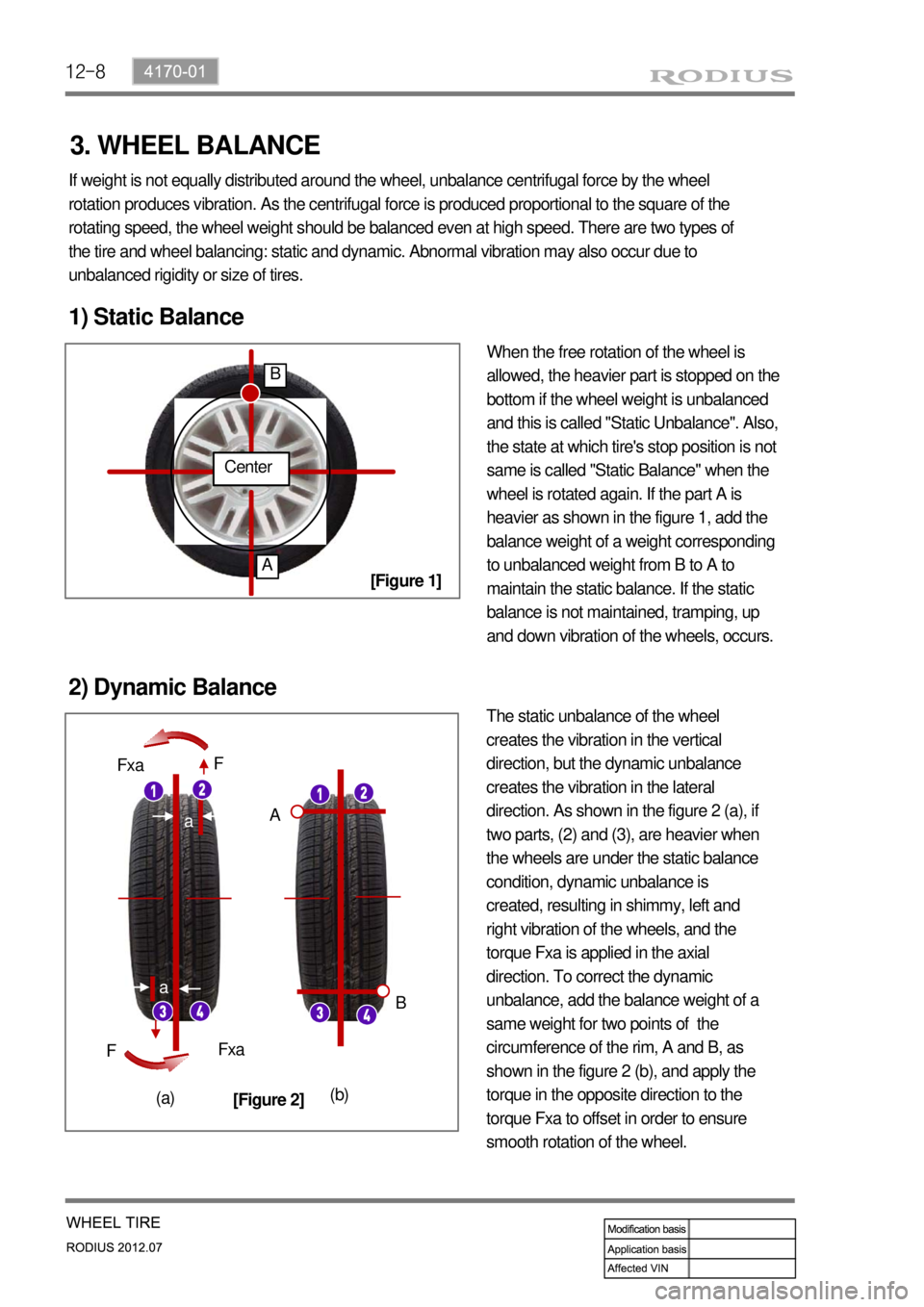
12-8
If weight is not equally distributed around the wheel, unbalance centrifugal force by the wheel
rotation produces vibration. As the centrifugal force is produced proportional to the square of the
rotating speed, the wheel weight should be balanced even at high speed. There are two types of
the tire and wheel balancing: static and dynamic. Abnormal vibration may also occur due to
unbalanced rigidity or size of tires.
1) Static Balance
When the free rotation of the wheel is
allowed, the heavier part is stopped on the
bottom if the wheel weight is unbalanced
and this is called "Static Unbalance". Also,
the state at which tire's stop position is not
same is called "Static Balance" when the
wheel is rotated again. If the part A is
heavier as shown in the figure 1, add the
balance weight of a weight corresponding
to unbalanced weight from B to A to
maintain the static balance. If the static
balance is not maintained, tramping, up
and down vibration of the wheels, occurs.
2) Dynamic Balance
The static unbalance of the wheel
creates the vibration in the vertical
direction, but the dynamic unbalance
creates the vibration in the lateral
direction. As shown in the figure 2 (a), if
two parts, (2) and (3), are heavier when
the wheels are under the static balance
condition, dynamic unbalance is
created, resulting in shimmy, left and
right vibration of the wheels, and the
torque Fxa is applied in the axial
direction. To correct the dynamic
unbalance, add the balance weight of a
same weight for two points of the
circumference of the rim, A and B, as
shown in the figure 2 (b), and apply the
torque in the opposite direction to the
torque Fxa to offset in order to ensure
smooth rotation of the wheel.
Center
A
B
a
a
Fxa
Fxa F
F
A
B
(a)(b)
[Figure 1]
[Figure 2]
3. WHEEL BALANCE